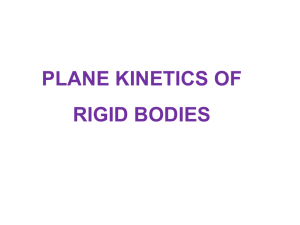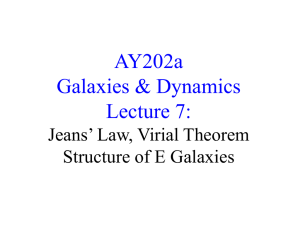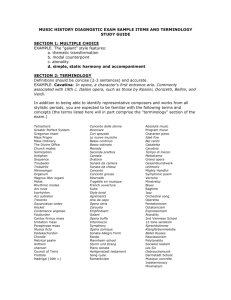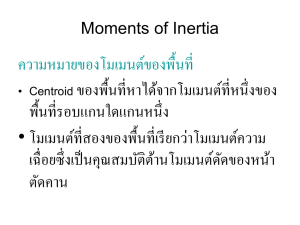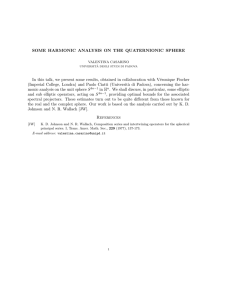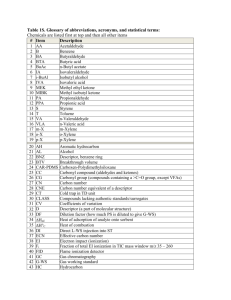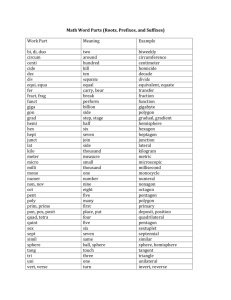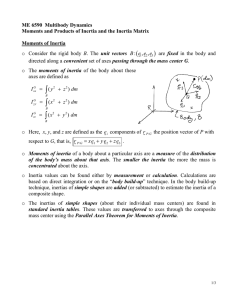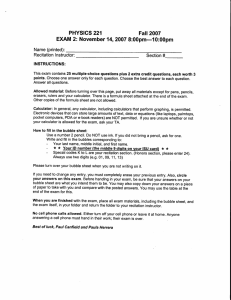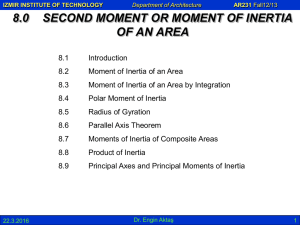ChiuRotationEx
advertisement
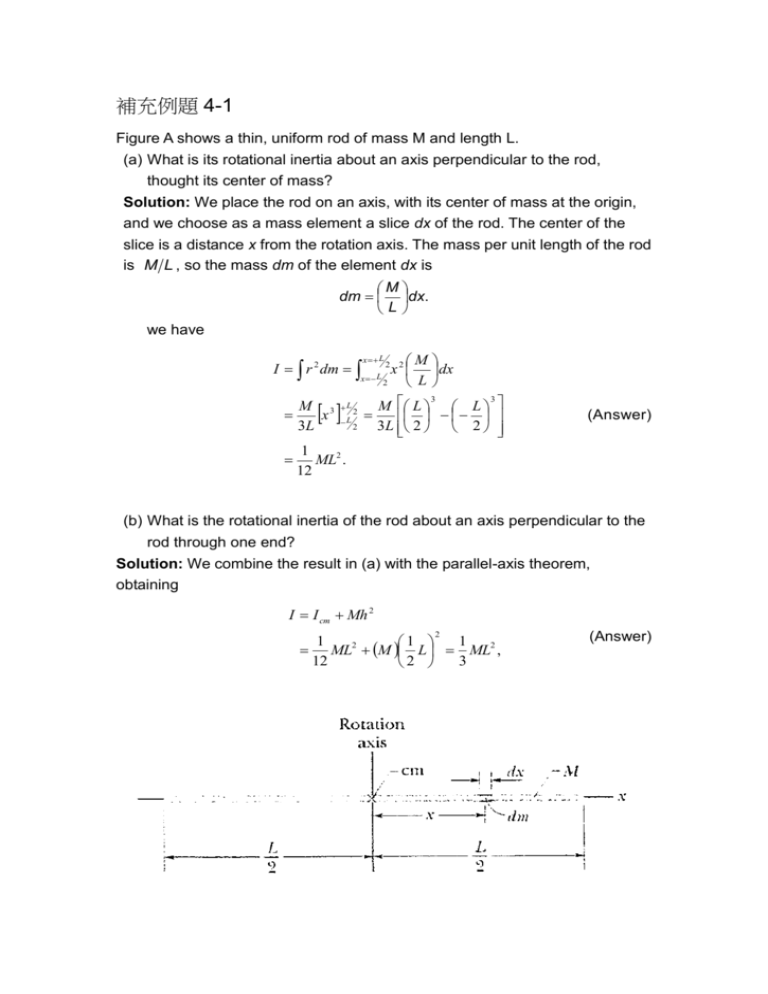
補充例題 4-1 Figure A shows a thin, uniform rod of mass M and length L. (a) What is its rotational inertia about an axis perpendicular to the rod, thought its center of mass? Solution: We place the rod on an axis, with its center of mass at the origin, and we choose as a mass element a slice dx of the rod. The center of the slice is a distance x from the rotation axis. The mass per unit length of the rod is M L , so the mass dm of the element dx is M dm dx. L we have I r 2 dm x L M 3 x 3L L L 2 M x 2 dx 2 L x L 2 2 3 3 M L L 3L 2 2 (Answer) 1 ML2 . 12 (b) What is the rotational inertia of the rod about an axis perpendicular to the rod through one end? Solution: We combine the result in (a) with the parallel-axis theorem, obtaining I I cm Mh 2 2 1 1 1 ML2 M L ML2 , 12 3 2 (Answer) 補充例題 4-2 Find the moment of inertia of a thin rod of mass M and length L about an axis at one end and perpendicular to the rod, as shown in Fig. B. Solution: The mass of an element of length dx is dm dx, where M L is the linear mass density. The moment of inertia of the mass element that is at a distance x from the axis is dI r 2 dm x 2 dx . For the entire rod the moment of inertia is L L3 0 3 I x 2 dx Since M L, (rod) I END ML2 3 補充例題 4-3 Find the moment of inertia of a circular disk or solid cylinder of radius R about the following axes: (a) through the center and perpendicular the flat surface; (b) at the rim and perpendicular to the flat surface. Solution: (a) Figure C shows that the appropriate mass element is a circular ring of radius r and width dr. Its area is dA 2rdr and its mass is dm dA, where M / A is the area mass density. The moment of inertia of this element is dI r 2 dm 2r 3 dr For the whole body,. R I 2 r 3 dr 0 1 R 4 2 The mass of the whole disk or cylinder is M A R 2 , and so (Disk or solid cylinder) ICM 1 MR 2 2 (b) The evaluation of the moment of inertia about an axis at the rim., as in Fig. C (b), by integration is difficult. The parallel axis theorem, with h=R, provides the answer with remarkable simplicity: I ICM Mh 2 1 3 MR 2 MR 2 MR 2 2 2 補充例題 4-4 Find the moment of inertia of a uniform solid sphere of mass M and radius R about a diameter. Solution: The sphere may be divided into disks perpendicular to the given axis, as in Fig. 11-8. The disk at a distance x from the center of the sphere has a radius r (R 2 x 2 )1 2 and a thickness dx. If M / V is the volume mass density (mass per unit volume), the mass of this elemental disk is dm dV r 2 dx , or dm R 2 x 2 dx From Eq. 11-19 the moment of inertia of this elemental disk is dI 2 1 1 dmr 2 R 2 x 2 dx 2 2 The total moment of inertia is I R 1 R 4 2R 2 x 2 x 4 dx 0 2 R 1 2 1 R 4 x R 2 x 3 x 5 2 3 5 0 8 R 5 15 4 The total mass of the sphere is M R 3 , so the moment of inertia may 3 be written as (Solid sphere) I 3 MR 2 5 (11-20a) This is the moment of inertia of a solid sphere about an axis through its center. In Problem 6 you are asked to show that the moment of inertia of a thin spherical shell. Of mass M and radius R. about an axis through its center is (Spherical Shell) I 2 MR 2 3 (11-20b) 補充例題 4-5 (a) Show that the moment of inertia of a thin spherical shell of mass M and 2 MR 2 . (Hint: Break the shell into rings 3 radius R about a diameter is and use the angle to the axis as the variable.) (b) Use part (a) to find the moment of inertia of a solid sphere of mass M and radius R. Solution: (a) dI r 2dm (R sin 2 )2 sinRd c 3 8R 4 I 2R 4 1 c 2 dc 2R 4 c 3 3 2MR 2 M 4R , so I 3 2 2dmr 2 2 4r 2 dr r 2 4R 3 (b) dI and M . 3 3 3 2MR 2 Integrate to find I . 5 補充例題 4-6 A bowing bull, whose radius R is 11cm and whose mass M is 7.2 kg, rolls from rest down a ramp whose length L is 2.1m. The ramp is inclined at an angle of 34 to the horizontal; see the sphere in Fig. 12-7. How fast is the ball moving when it reaches the bottom of the ramp? Assume the ball is uniform in density. Solution: The center of the ball falls a vertical distance h L sin ; so the decrease in gravitational potential energy is MgL sin . This loss of potential energy equals the gain in kinetic energy. Thus we can write (see Eq.12-5) MgL s i n 1 1 2 I cm 2 Mvcm 2 2 From Table 11-2(g) we see that, for a solid sphere, I cm replace with its equal, v cm R (12-6) 2 MR 2 . We can also 5 Substituting both these quantities into Eq. 12-6 yields 2 1 v 1 2 2 MgL s i n MR 2 cm Mv cm 2 2 3 R (12-6) Solving for 10 10 v cm gL sin 9.8 m 2 2.1m sin 34 4.1m s s 7 7 (Answer) Note that the answer does not depend on the mass or radius of the ball. 圖 Figure 12-7 Sample Problem 12-2 and 12-3. A hoop, a disk, and a sphere roll from rest down a ramp of angle . Although released from rest at the same position and time, they arrive at the bottom in the order shown. Halliday 5th 12-2 補充例題 4-7 Here we generalize the result of Sample Problem 12-2. A uniform hoop, disk, and sphere, having the same mass M and the same radius R, are released simultaneously from rest at the top of a ramp whose length L is 2.5m and whose ramp angle is 12 (Fig. 12-7) (a) Which object reaches the bottom first? Solution: Table 12-1 gives us the answer. The sphere outs the largest share of its kinetic energy (71%) into translational motion, so it wins the race. Next comes the disk and then the hoop. (b) How fast are the objects moving at the ramp’s bottom? Solution: The center of mass of each object rolling down the ramp falls the same vertical distance h. Like a body in free fall, the object loses potential energy in amount Mgh and thus gains this amount of kinetic energy. At the bottom of the ramp then, the total kinetic energies of all three objects are the same. How these kinetic energies are divided between the translational and rotational forms depends on each object’s distribution of mass. From Eq.12-5 we can write (putting v cm ) R 1 1 2 I cm 2 Mv cm 2 2 2 1 1 v cm 2 I cm 2 Mv cm 2 R 2 Mgh 1 I cm 2 1 2 2 v cm Mv cm 2R 2 Putting h L sin and solving for v CM , we obtain (12-7) v cm 2gL s i n I 1 cm MR 2 (Answer) (12-8) which is the symbolic answer to the question. Note that the speed depends not on the mass or the radius of the rolling object, but only on the distribution of its mass about its central axis, which enters through the term I cm MR 2 . A marble and a bowling ball will have the same speed at the bottom of the ramp and will thus roll down the ramp in the same time. A bowling ball will beat a disk of any mass or radius, and almost anything that rolls will beat a hoop. For the rolling hoop (see the hoop listing in Table 12-1), we have I cm 1 , so Eq.12-8 yields MR 2 v cm 2gL sin I 1 cm MR 2 2 9.8 m s 2 2.5m sin12 2 .3 m 1 1 (Answer) s From a similar calculation, we obtain v cm 2.6 m s for the disk ( I cm 1 ) 2 2 MR I cm 2 ). This supports our prediction of (a) 2 5 MR that the win, place, and show sequence in this race will be sphere, disk, and hoop. and 2.7 m s for the sphere (

